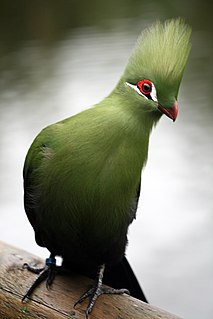
The turacos make up the bird family Musophagidae ( "banana-eaters"), which includes plantain-eaters and go-away-birds. In southern Africa both turacos and go-away-birds are commonly known as loeries. They are semi-zygodactylous: the fourth (outer) toe can be switched back and forth. The second and third toes, which always point forward, are conjoined in some species. Musophagids often have prominent crests and long tails; the turacos are noted for peculiar and unique pigments giving them their bright green and red feathers.
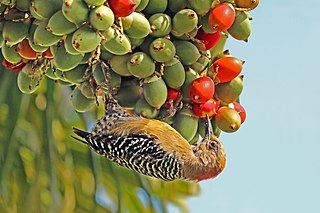
Nine families of largely arboreal birds make up the order Piciformes, the best-known of them being the Picidae, which includes the woodpeckers and close relatives. The Piciformes contain about 71 living genera with a little over 450 species, of which the Picidae make up about half.

The mousebirds are birds in the order Coliiformes. They are the sister group to the clade Eucavitaves, which includes the Leptosomiformes, Trogoniformes (trogons), Bucerotiformes, Piciformes and Coraciformes. This group is now confined to sub-Saharan Africa, and it is the only bird order confined entirely to that continent, with the possible exception of turacos which are considered by some as the distinct order Musophagiformes, and the cuckoo roller, which is the only member of the order Leptosomiformes. Mousebirds had a wider range in the Paleogene, with a widespread distribution in Europe and North America during the Paleocene.

New World barbets are near passerine birds from the family Capitonidae of the order Piciformes which inhabit humid forests in Central and South America. They are closely related to the toucans.

Tringa is a genus of waders, containing the shanks and tattlers. The genus name Tringa is the New Latin name given to the green sandpiper by the Italian naturalist Ulisse Aldrovandi in 1599. They are mainly freshwater birds, often with brightly coloured legs as reflected in the English names of six species, as well as the specific names of two of these and the green sandpiper. They are typically associated with northern hemisphere temperate regions for breeding. Some of this group—notably the green sandpiper—nest in trees, using the old nests of other birds, usually thrushes.
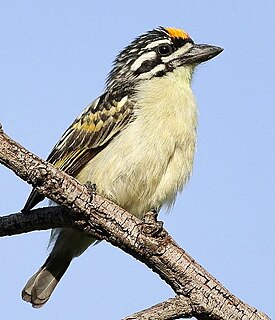
The yellow-fronted tinkerbird is a small African barbet formerly known as yellow-fronted tinker barbet. It is sometimes considered conspecific with its southern counterpart, the red-fronted tinkerbird, Pogoniulus pusillus. Barbets are near passerine birds with bristles around the base of the bill and a world-wide tropical distribution.
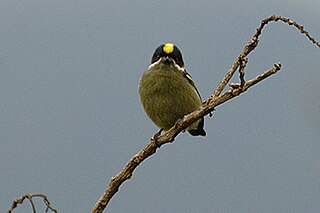
The tinkerbirds or tinker barbets are the genus Pogoniulus of the Lybiidae, the African barbet family of near passerines, which was formerly included in the Capitonidae and sometimes in the Ramphastidae. Tinkerbirds are widely distributed in tropical Africa.
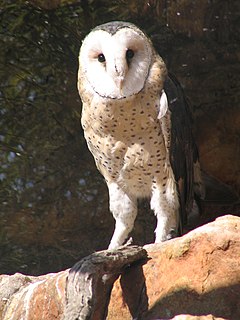
Tyto is a genus of birds consisting of true barn owls, grass owls and masked owls that collectively make up all the species within the subfamily Tytoninae of the barn owl family, Tytonidae.

The toucan barbet is a barbet native to western Ecuador and Colombia. Along with the prong-billed barbet, it forms the family Semnornithidae, and is closely related to the toucans. It is a medium-sized barbet with a robust yellow bill. It has striking plumage, having a black head with grey throat and nape, red breast and upper belly, yellow lower belly and grey wings and tail.
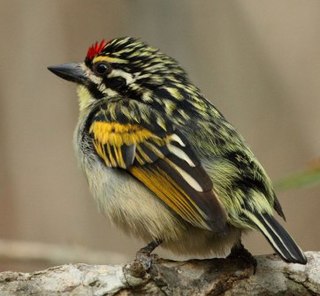
The red-fronted tinkerbird, is a small African barbet. Barbets are near-passerine birds with bristles around the base of the bill. They have a world-wide tropical distribution.

Lybius is a genus of African barbets from the family Lybiidae. This genus ranges across sub-Saharan Africa.
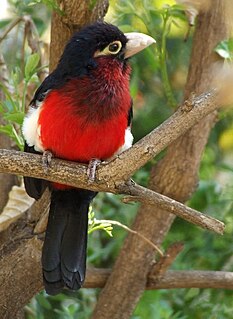
The double-toothed barbet is a species of bird in the family Lybiidae. It is found in Angola, Benin, Burundi, Cameroon, Central African Republic, Republic of the Congo, Democratic Republic of the Congo, Ivory Coast, Equatorial Guinea, Ethiopia, Gabon, Ghana, Guinea, Guinea-Bissau, Kenya, Liberia, Mali, Nigeria, Rwanda, Sierra Leone, South Sudan, Tanzania, Togo, and Uganda. Within Lybius bidentatus, there are two subspecies: Lybius bidentatus bidentatus and Lybius bidentatus aequatorialis.

The black-collared barbet is a species of bird in the family Lybiidae which is native to sub-Saharan Africa. Indigenous names include isiKhulukhulu and isiQonQotho in isiZulu, and Isinagogo in isiXhosa.

The banded barbet is a species of bird in the family Lybiidae. It is found in Eritrea and Ethiopia.
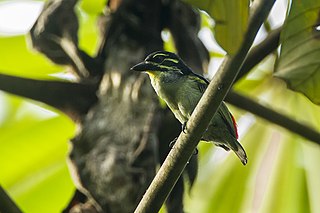
The red-rumped tinkerbird is a species of bird in the Lybiidae family . It is widely spread across the African tropical rainforest.

The yellow-rumped tinkerbird is a bird species in the family Lybiidae, which is native to the moist tropical and subtropical regions of sub-Saharan Africa.
The white-chested tinkerbird is a species of bird in the Lybiidae family . It is endemic to the Zambezian Cryptosepalum dry forests of Zambia. It is only known from the single type specimen, collected in 1964 by Jali Makawa, the field assistant and collector for Constantine Benson. Genetic evidence suggests that it may not a separate species, but instead be a population embedded within the yellow-rumped tinkerbird if it is not an aberrant individual.

The yellow-throated tinkerbird is a species of bird in the Lybiidae family.

The African terrestrial barbets are the bird genus Trachyphonus in the African barbet family (Lybiidae), which was formerly included in the Capitonidae and sometimes in the Ramphastidae. These birds are more terrestrial than the other African barbets and differ in some other respects too; they are thus separated in a monotypic subfamily Trachyphoninae.
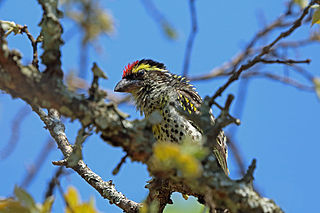
The miombo pied barbet is a species of bird in the family Lybiidae. It is found in south-central Africa.




















